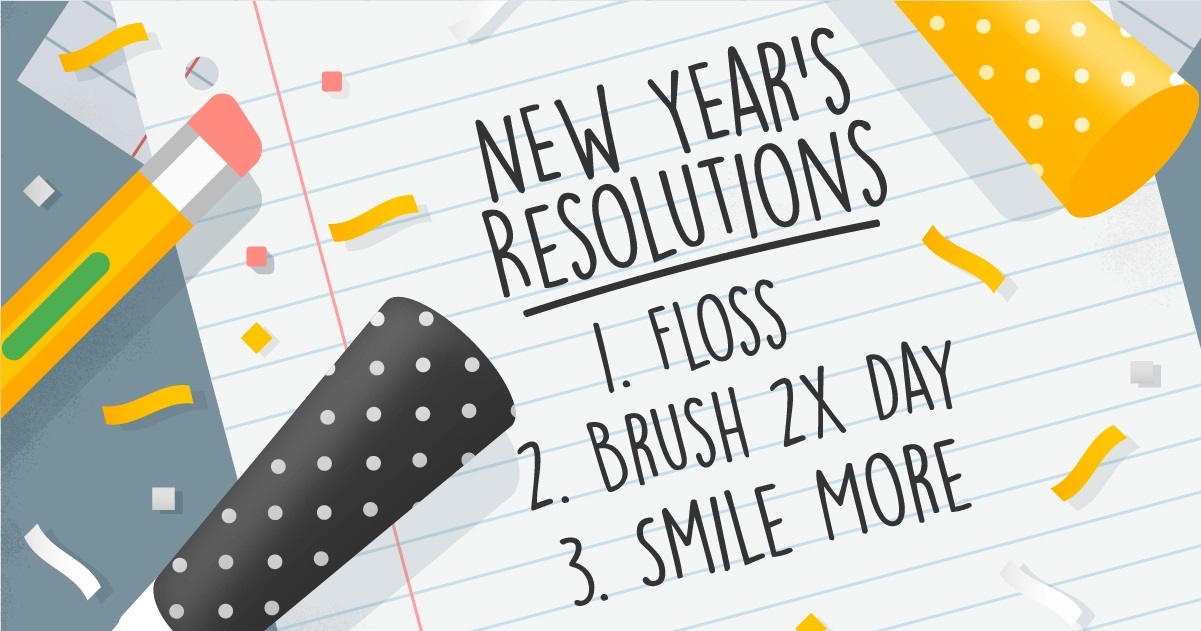New Year’s Resolutions for Your Dental Health

Resolutions for Your Dental Health
1.Brush twice a day with the correct equipment
Toothbrushing twice a day will clean approximately 60% of the surfaces of the teeth.
Be sure to use either a soft manual toothbrush or a rotary electric toothbrush twice every day for good dental health. The plaque and food debris that you are brushing off is very soft so can easily be brushed off with soft bristles.
A medium or hard toothbrush is too firm and is likely to cause gum recession and scrub away the tooth enamel and dentine over time. A firmer brush won’t remove more debris than a soft toothbrush. Once scrubbed away, teeth and gum don’t grow back or regenerate.
The rotary electric toothbrushes are better than the vibrating kind of electric brushes. We want a toothbrush that will gently massage the teeth and gums and mimic the action of a hygienist polishing your teeth. The Oral B/Braun brand has been around for many years and replacement heads are easily available, with Woolworths even selling their own Home Brand replacement heads that are compatible with the base unit. This is the brand of brush you will find in most dental personnel’s bathrooms.
Vibrating toothbrushes without the oscillating action tend to be too vigorous and often lead to gum and teeth abrasion so avoid these.
Ensure you are using a Fluoride toothpaste to reduce risk of decay. The big brands of toothpaste such as Colgate, Oral B, Macleans and Sensodyne all contain fluoride and are good for dental health. After brushing we suggest that you spit out the excess paste, but NOT rinse with water. This allows the remnants of the fluoride in the toothpaste to have prolonged exposure to the teeth and reduce the risk of cavities.
Sensitive toothpastes contain the same amount of fluoride that the other toothpastes contain, so by using these products you aren’t losing the cavity fighting power by choosing a sensitive toothpaste.
Avoid toothpastes that are labelled as “whitening” or containing charcoal. These pastes are very abrasive and will often lead to an increase in gum and teeth abrasions and areas of sensitivity. The truth about these products is that they don’t contain enough whitening agents to cause any change in colour.
For those that dislike a minty-tasting toothpaste there are alternative products available that still contain the protection of fluoride. Soul Pattinson Pharmacy have a flavour-free toothpaste that is particularly popular with patients with low sensory tolerance.
2. Replace your toothbrush
Your regular toothbrush or electric toothbrush head should be replaced every 3 months, or sooner if the bristles become splayed or flattened. Once the brush appears splayed, the gentle edges of the bristles are gone, and the jagged edges of the bristles are exposed. Brushing with worn bristles isn’t effective for plaque removal and the jagged edges easily lacerate your fragile gum tissue.
You should replace your toothbrush immediately after any cold or flu-like illnesses to prevent recontamination for better dental health. The porosities in the toothbrush bristles are ideal for harboring the bugs that cause these illnesses.
Most toothbrushes have indicator bristles that will lose colour which will remind you to add a toothbrush or electric toothbrush head refill to your shopping list.
3. Floss every day
The surfaces between your teeth are called the “Interproximal surfaces” and these make up the 40% of the surfaces that your toothbrush cannot reach. There are many different Interproximal gadgets that are available to clean these areas.
Even the healthiest diet will result in plaque and plaque acids being deposited on your teeth. To prevent gum problems and dental decay, all of the plaque needs to be removed regularly.
There are many different brands of floss available, and there isn’t really a brand that is better than any other. Some people prefer the feeling of waxed or tape or flavoured floss. It’s really a personal preference for your dental health.
There are gadgets such as the Reach Access Flosser which is fantastic for children and those with arthritis, big hands, and disabilities.
Little brushes that go between your teeth (where people usually use a toothpick) are great for cleaning teeth. There are many brands available and a lot of sizes to choose from. Here at Grandis Dental, we like Piksters.com These are available in different sizes and are the most biodegradable and sustainable interproximal brushes that are available. It’s important to choose the size that smoothly slides between your teeth without being forced. Using an interproximal brush that is too big for a gap is likely to cause the gum to recede- and it won’t grow back.
Flossing or interproximal brushing can be done any time of the day, so long as it is done at least once every 24 hours.
4. Ditch the Mouthwash
There is no need to include a commercial mouthwash in your daily oral care routine. There is no mouthwash that can replace flossing.
Commercial mouthwash products that are sold are ineffective at removing the bad bacteria that live under the gum but will kill off the good bacteria that keep your mouth healthy. They will leave stubborn stains on your teeth that can only be removed by a dental professional and can sometimes alter your taste sensation. Despite successful marketing campaigns, the current research concludes that mouthwashes will not “blast” bacteria from under your gums.
5. Cut down on sugar and make sure you have healthy food options available.
Food doesn’t need to be boring or unhealthy. Cheese with crackers, yoghurt, sushi, fresh fruit, and dips with raw veggies are quick and healthy snacks that are delicious and nutritious. You’ll find that if you don’t have sugary snacks in the house, you’ll crave them less.
Even eating very healthy snacks will leave plaque acid on the teeth. Tooth enamel that has frequent exposure to plaque acid without time to be buffered by saliva leaves this tooth enamel prone to decay. Limit the intake of treats to a certain time in the morning and afternoon.
6. Drink more water
Water is what helps your body uses to produce saliva. Saliva is important as it washes away food and neutralizes acids that are produced by bacteria in the mouth. We advise against using sports drinks that are marketed as having a large quantity of “electrolytes” in them. These contain enormous amounts of sugar and are not what you should use to rehydrate yourself. Frequent sips of water are best.
7. Quit smoking
Smokers are at a significantly higher risk of certain dental problems as well as medical problems.
Smoking can lead to tooth staining, gum disease, tooth loss, and in more severe cases, mouth cancer. Many smokers already feel guilt about their habit, so we’ll never harp on about it here at Grandis Dental health clinic. We will always encourage you to reduce consumption and eventually quit.
There is great dental health information available at www.makesmokinghistory.org.au
8. Fix your teeth
Put aside the time to get your outstanding dental health treatment completed.
Unfortunately, ignoring dental problems is very common, usually as dental treatment can be costly and time consuming. We suggest making regular weekly, fortnightly or monthly appointments to gradually work through your treatment plan. There is nothing quite like the satisfaction of completing a treatment plan that you’ve steadily worked your way through.
9. Enhance your smile
Many of us want to have a lighter and brighter smile and doing some tooth whitening can be an effective and non-invasive way to achieve this. Tooth enamel varies in colour from person to person and the results will vary from person to person also. Enamel is classified into shades of yellow and grey and mixtures of both. Tooth whitening removes the yellowish tint from enamel, leaving the teeth much whiter afterwards. For this reason, tooth whitening procedures work best on those with yellow shades but will still lift grey tones a few shades lighter. There are several different ways to effectively whiten your teeth.
The optimum home dental health solution is a Custom-made home whitening kit. Dental impressions are taken of the upper and lower teeth and from these we make custom upper and lower whitening trays. These trays are made to hold the 9.5% solution directly onto the tooth and minimise any excess gel being wasted. Home kits have been used for decades as they are a predictable and gentle way to whiten teeth.
The ultimate whitening solution for dental health is the Professional Dental Tooth Whitening which is done in the dental chair. This is a 37.5% solution and is only available at a dental clinic. The professional whitening is done in a single appointment taking approximately 90 mins. A protective barrier is painted on the gums and then the whitening gel is painted onto the teeth, and then activated by an LED light for an 8-minute cycle. Usually, 4 cycles of 8 minutes are completed, but this varies from person to person. Some people have some sensitivity after 3 cycles and elect to stop, and some have no sensitivity and do a 5th cycle at no charge. The results after the Professional whitening are best seen approximately 5 days after the appointment once the enamel shade has settled. This option comes with a free top up home whitening pen every 6 months at your hygiene appointment, so long as you keep up your regular dental health checkup appointments.
At Grandis Dental we like to combine the Professional Dental tooth Whitening and Home Custom Kit to give the best results. We regularly have this combination as our Product of the Month, so ask when you’re in next- you might find out that this is a more cost-effective dental health option that you thought.
At Grandis Dental we only use Pola brand tooth whitening products. These are the only products available that are pH neutral, so cause less sensitivity and won’t give a false result by dehydrating the teeth. Pola is owned and manufactured in Australia, and we proudly use their products.
10. Make sure you have your hygiene maintenance appointment booked
These dental health appointments give our hygienists the opportunity to smooth over older fillings or restorations to remove plaque traps and to try to extend the lifespan of older restorations by a few months or years. We know that older restorations will eventually need replacement, but we can often make restorations last a little longer with some simple maintenance carried out during a hygiene session.
Hygienists are often the first clinicians to find cracks and decay that are hidden under deposits of plaque and tartar. Early detection of cracks and decay often means shorter and cheaper restorative appointments with our dentists.
Do you have any questions about New Year’s Dental Resolutions? Call our friendly admin team on (08) 6404 2899.
Also, don’t forget to have a look at our other dental health blogs on our website for more educational information.






